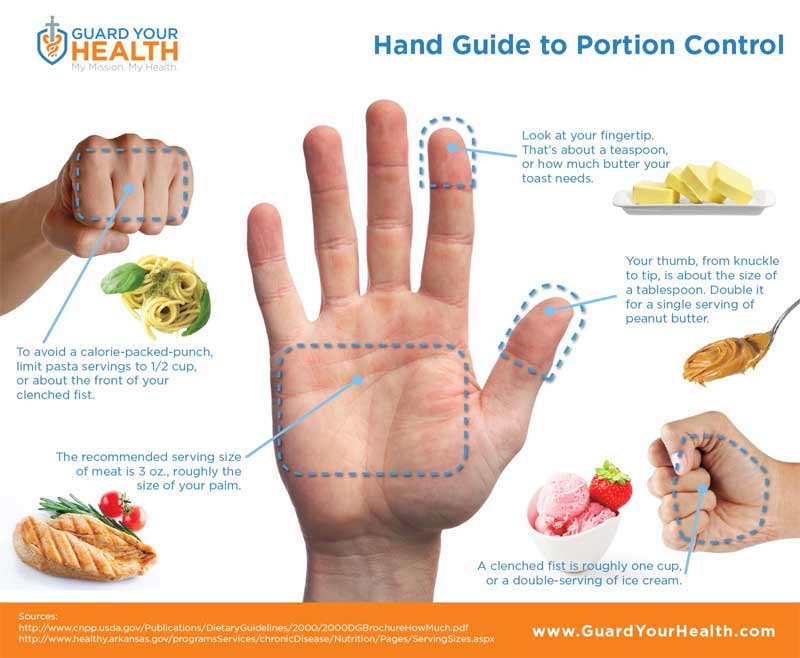Secret #52 Eating Well

When I got sick and had my heart operation I was given some training re eating. Most of my life eating habits was not bad but also not great.
The key to all good eating is portion control. A portion for an older person is smaller than the average because they are not quite as active.
In my case a portion is the size of my palm. So steak, fish etc. should be no bigger than my palm which is close to 85 – 100 grams.
Because I now eat certain portion sizes and they are a lot smaller than I was used to I was able to buy higher quality and leaner meats which helped cholesterol and also tasted a lot nicer.
Now we mix with that a mix of vegetables or salads.
Sugars and Spiking
Being a diabetic, ok I know I have lots of things wrong with me but with good planning I live a pretty healthy and fulfilling life. Eating high GI (glycaemic index) foods is not a good idea for any aged person. Things like white foods, bread, rice, pasta etc. will cause spikes in your sugars. High carbs also do this.
Drink Some Water
Water supports and provides many vital functions in the body, including hydration, digestion and blood volume, however as you age you may not feel thirsty as often, even when your body needs fluid.
Aim to drink at least six times a day, and more in warmer weather or if you’re exercising. Tea, coffee, mineral water, soda water and reduced fat milk can all count towards your fluid intake during the day, but water is always best!
What seems to be missing is that when you drink a lot of water you are also diluting the salts your body requires so especially in summer drink some hydrolytes every now and then. You can pick them up in a chemist or supermarket.
Balanced Intake
As we get older we often need fewer kilojoules because we are less active than when we were younger. However, we still need a similar amount of nutrients, sometimes more. For example, as we age our requirement for calcium increases and we need extra serves of low fat milk, yogurt and cheese.
This means our choices must be nutrient dense but not energy dense and we should be careful to choose discretionary foods only occasionally as these are higher in kilojoules.
What should I eat?
- Fruits.
- Vegetables.
- Grains (for example breads, cereals, rice, pasta, oats)
- Meats, poultry, fish, eggs, tofu, nuts, seeds and legumes/beans.
- Milk, yoghurt and cheese (or other dairy products).
Dietary Guideline 1:
To achieve and maintain a healthy weight, be physically active and choose amounts of nutritious food and drinks to meet your energy needs
Older people should eat nutritious foods and keep physically active to help maintain muscle strength and a healthy weight.
Achieving and maintaining a healthy weight can help older people keep more active, manage their health problems better and live life more. The best way to do this is to try to follow the recommended number of serves from the five food groups and avoid extra serves and discretionary foods and drinks.
However, we also know that people who are over 65 years often have better health if they carry a little extra weight and have a slightly higher body mass index. Sometimes too, people with chronic health problems can put themselves at risk of malnutrition by restricting what they eat. If you are unsure about the benefits of losing extra weight, talk to your health professional.
Dietary Guideline 2:
Enjoy a wide variety of nutritious foods from these five groups every day
Circumstances, health problems, budgets and eating issues can mean that our range of foods gets smaller as we get older. However, it remains important to eat widely from all the food groups to make sure we get the nutrients we need.
Troubleshooting and a few tips can keep a wide variety of foods in our meals and snacks. If your budget is more limited, plan well, use what’s available and buy only what you need. If you’re cooking for one, collect some healthy, but quick and easy ideas and try to organise to eat regularly with friends or family. If nuts, grains and hard fruits and vegetables are a problem for your teeth, go for milled whole grains, soft cooked and canned fruits and vegetables and nut pastes.
Be careful to follow food safety guidelines, because food borne illnesses can hit older people particularly hard.
Dietary Guideline 3:
Limit intake of foods and drinks containing fat, added salt, added sugars and alcohol
It’s always good to limit saturated fats, added salt, added sugars, alcohol and low fibre choices for good health. However older people are also more likely to be living with a chronic disease and part of their self management might involve careful attention to choosing foods.
Sometimes though, limiting fats, added salt and added sugars can mean a person who is at risk of malnutrition, actually eats too few nutrients and kilojoules and can put themselves at risk. For some people it’s not straightforward and they need to talk to their health professional about the benefits and risks.
Older people can also find that they need to eat more high fibre foods and to drink more water to avoid constipation as bowels tend to slow down with age.
Due to my previous illnesses I learnt quite a bit about eating healthy and even as I was progressing it changed. The key I gained was its all about portion control.
By controlling portions it allows us to eat better quality food because we are not eating as much but getting more from it.
Retirement has been a discovery of beauty for me. I never had the time before to notice the beauty of my grandkids, my wife, the tree outside my very own front door. And, the beauty of time itself.
Hartman Jule
So the old rules are still best. 1 portion of meat and 5 portions of veggies plus a piece of fruit a day. Keep away from too much sugar.

Some protein, dairy, grain breads and nuts. Pretty simple really.
Hope you enjoyed the book
Quentin Brown